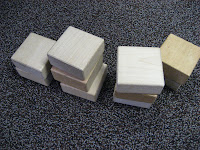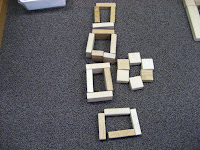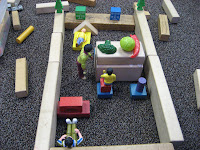
 I'm currently involved in an intensive Positive Behavior Support (PBS) training. Yesterday was the first day of our training and the facilitators were laying the foundation and the ideas that improving challenging behavior and creating a classroom climate for emotional literacy often takes a long time. There are no quick fixes.
I'm currently involved in an intensive Positive Behavior Support (PBS) training. Yesterday was the first day of our training and the facilitators were laying the foundation and the ideas that improving challenging behavior and creating a classroom climate for emotional literacy often takes a long time. There are no quick fixes.This reminded me of the Bamboo Story. A collegue gave me a copy of this story quite a few years ago. It was hanging behind my desk as a gentle reminder for my assistant and me. I have no idea what happened to it. It probably fell down at some point and accidentally got thrown away. I've tried to find the same story online, but to no avail. Here is what I remember and the message I took from the story I received so long ago.
The Bamboo Story:
Once upon a time there was a farmer who planted some bamboo seeds. Each day he diligently cared for his bamboo seeds in the hope that he would see the fruits of his labor in wonderful bamboo growth.
The first year passed with daily care. And yet nothing happened. No bamboo sprouted.
The farmer was undaunted. He continued his daily watering, weeding and care of his bamboo seeds.
The second year passed and nothing happened.
At this point the farmer was beginning to feel discouraged. He had consistently worked; nurturing and caring for his bamboo seeds, and yet he saw no growth.
The third year passed and suddenly his bamboo was growing a foot each m onth. By the end of the year his bamboo was over 12 feet tall! Finally, the farmer had evidence of his growth.
onth. By the end of the year his bamboo was over 12 feet tall! Finally, the farmer had evidence of his growth.
 onth. By the end of the year his bamboo was over 12 feet tall! Finally, the farmer had evidence of his growth.
onth. By the end of the year his bamboo was over 12 feet tall! Finally, the farmer had evidence of his growth.So the question is, did the bamboo grow 12 feet in that final year when the growth was evident and measured? Or did the bamboo grow 12 feet in 3 years through the daily care?
It is said that during the first two years the bamboo IS growing. It is said that the bamboo is growing roots below the ground that are a foundation strong enough to support the future growth spurt. It is said that growth was occuring as the farmer was caring for the seeds, the farmer just couldn't see it.
My recent training in PBS strategies made me think of this story again. Often it takes a long time for children with challenging behaviors to demonstrate skills of regulating their own behavior, resolving conflict or problem solving.
So as we begin our journey with positive behavior support, we as teachers must persist as the farmer did. Continually providing the daily care and nurturing of our students' emotional literacy. Those students may leave our classrooms without us seeing evidence of their growth. But perhaps, they grow by leaps and bounds one year. Perhaps those years of daily care including work on emotional vocabulary, directly and indirectly teaching social skills and providing support was a foundation for that growth. And perhaps the child's skills grew over the course of several years, but we just saw evidence of it in one.
our students' emotional literacy. Those students may leave our classrooms without us seeing evidence of their growth. But perhaps, they grow by leaps and bounds one year. Perhaps those years of daily care including work on emotional vocabulary, directly and indirectly teaching social skills and providing support was a foundation for that growth. And perhaps the child's skills grew over the course of several years, but we just saw evidence of it in one.
 our students' emotional literacy. Those students may leave our classrooms without us seeing evidence of their growth. But perhaps, they grow by leaps and bounds one year. Perhaps those years of daily care including work on emotional vocabulary, directly and indirectly teaching social skills and providing support was a foundation for that growth. And perhaps the child's skills grew over the course of several years, but we just saw evidence of it in one.
our students' emotional literacy. Those students may leave our classrooms without us seeing evidence of their growth. But perhaps, they grow by leaps and bounds one year. Perhaps those years of daily care including work on emotional vocabulary, directly and indirectly teaching social skills and providing support was a foundation for that growth. And perhaps the child's skills grew over the course of several years, but we just saw evidence of it in one.

